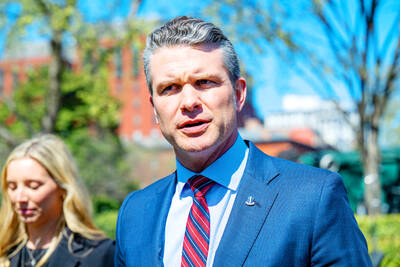The Guanwu Salamander Ecology Center opened to the public yesterday in the Shei-pa National Park’s Guanwu Recreation Area.
The guanwu salamander (Hynobius formosanus) is a nocturnal amphibian that inhabits mountainous areas above 1,300m in central and northern Taiwan, and is a relic from the Ice Age, like the famous Formosan landlocked salmon, the center said.
The species was first found in 2008 near Guanwu (觀霧) and has been listed as an endangered species by the Council of Agriculture.
Three years ago, the national park began research on the creature and restored a habitat near the center to conserve the species, the center said, adding that the successful habitat restoration was recognized by the International Society for Ecological Restoration last year.
Through photographs and video documentaries, the center shows the life-history and habitat of the guanwu salamander, which is about 10cm long with dark brown skin and tiny white spots.
Other than restoring its habitat and conducting experiments, Lin Ching (林青), director of the national park, said the park has remodeled its visitor center into a new ecology center to educate visitors about the area’s unique environmental features.
Lin said increasing attention was being paid to the impact of climate change on various at-risk species, so the conservation and habitat restoration of the guanwu salamander at Shei-pa National Park was an important achievement, on a par with efforts to conserve the Formosan landlocked salmon.
Minister of the Interior Lee Hong-yuan (李鴻源), who attended the opening ceremony, said he hoped the center could also bring ecotourism benefits to nearby Aboriginal villages.

A magnitude 4.9 earthquake struck off Tainan at 11:47am today, the Central Weather Administration (CWA) said. The hypocenter was 32.3km northeast of Tainan City Hall at a depth of 7.3km, CWA data showed. The intensity of the quake, which gauges the actual effect of a seismic event, measured 4 in Tainan and Chiayi County on Taiwan's seven-tier intensity scale, the data showed. The quake had an intensity of 3 in Chiayi City and County, and Yunlin County, while it was measured as 2 in Kaohsiung, Nantou County, Changhua County, Taitung County and offshore Penghu County, the data showed. There were no immediate reports of

‘DENIAL DEFENSE’: The US would increase its military presence with uncrewed ships, and submarines, while boosting defense in the Indo-Pacific, a Pete Hegseth memo said The US is reorienting its military strategy to focus primarily on deterring a potential Chinese invasion of Taiwan, a memo signed by US Secretary of Defense Pete Hegseth showed. The memo also called on Taiwan to increase its defense spending. The document, known as the “Interim National Defense Strategic Guidance,” was distributed this month and detailed the national defense plans of US President Donald Trump’s administration, an article in the Washington Post said on Saturday. It outlines how the US can prepare for a potential war with China and defend itself from threats in the “near abroad,” including Greenland and the Panama

The Chinese Nationalist Party (KMT) is maintaining close ties with Beijing, the Democratic Progressive Party (DPP) said yesterday, hours after a new round of Chinese military drills in the Taiwan Strait began. Political parties in a democracy have a responsibility to be loyal to the nation and defend its sovereignty, DPP spokesman Justin Wu (吳崢) told a news conference in Taipei. His comments came hours after Beijing announced via Chinese state media that the Chinese People’s Liberation Army’s Eastern Theater Command was holding large-scale drills simulating a multi-pronged attack on Taiwan. Contrary to the KMT’s claims that it is staunchly anti-communist, KMT Deputy

RESPONSE: The government would investigate incidents of Taiwanese entertainers in China promoting CCP propaganda online in contravention of the law, the source said Taiwanese entertainers living in China who are found to have contravened cross-strait regulations or collaborated with the Chinese Communist Party (CCP) could be subject to fines, a source said on Sunday. Several Taiwanese entertainers have posted on the social media platform Sina Weibo saying that Taiwan “must be returned” to China, and sharing news articles from Chinese state media. In response, the Mainland Affairs Council (MAC) has asked the Ministry of Culture to investigate whether the entertainers had contravened any laws, and asked for them to be questioned upon their return to Taiwan, an official familiar with the matter said. To curb repeated